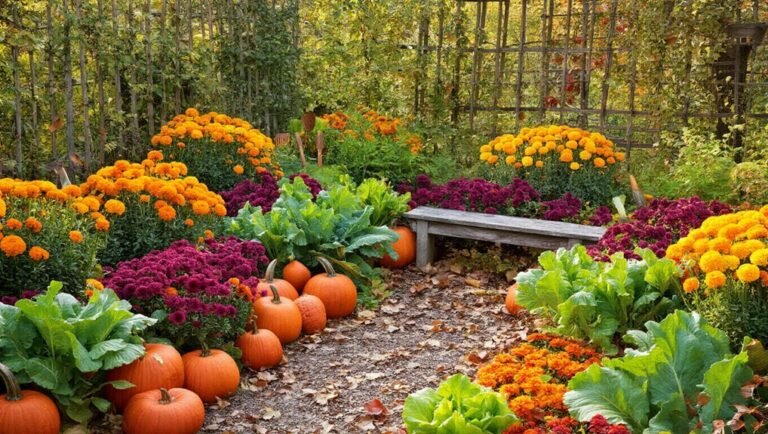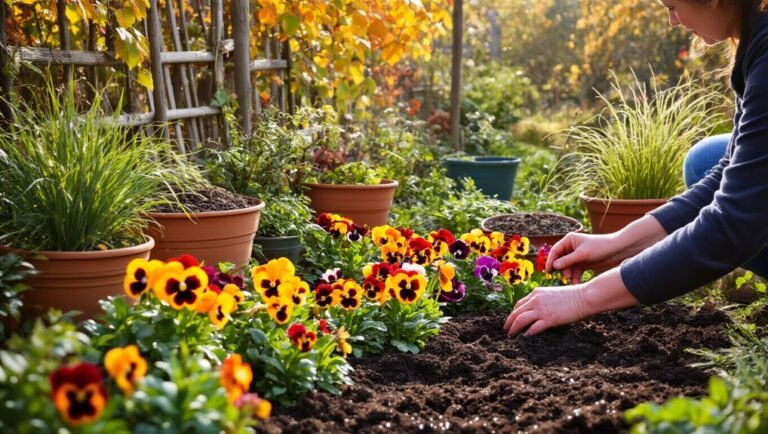For vibrant, low-maintenance flower beds, consider “bomb-proof” perennials like Achillea millefolium (Yarrow), Echinacea purpurea (Purple Coneflower), and Rudbeckia hirta (Black-Eyed Susan). These plants thrive in full sun, tolerate drought, and attract beneficial pollinators. You’ll also find stunning options like Sedum spp. (Stonecrop) and Lavandula angustifolia (English Lavender) that bring beauty and fragrance. Each offers resilience in tough conditions, ensuring your garden stays beautiful with minimal effort. There’s more to explore about these resilient beauties!
Key Takeaways
- Achillea Millefolium (Yarrow): Resilient, drought-tolerant, and attracts pollinators, making it perfect for sunny flower beds.
- Echinacea Purpurea (Purple Coneflower): Hardy and long-blooming, it thrives in full sun and attracts bees and butterflies.
- Rudbeckia Hirta (Black-Eyed Susan): Cheerful yellow flowers bloom from summer to fall, thriving in well-drained soil and attracting beneficial pollinators.
- Sedum Spp. (Stonecrop): Low-maintenance and drought-tolerant, it features varied shapes and colors, perfect for sunny locations.
- Lavandula Angustifolia (English Lavender): Offers fragrance, drought tolerance, and attracts pollinators, with culinary and skincare uses for its flowers.
Achillea Millefolium (Yarrow)
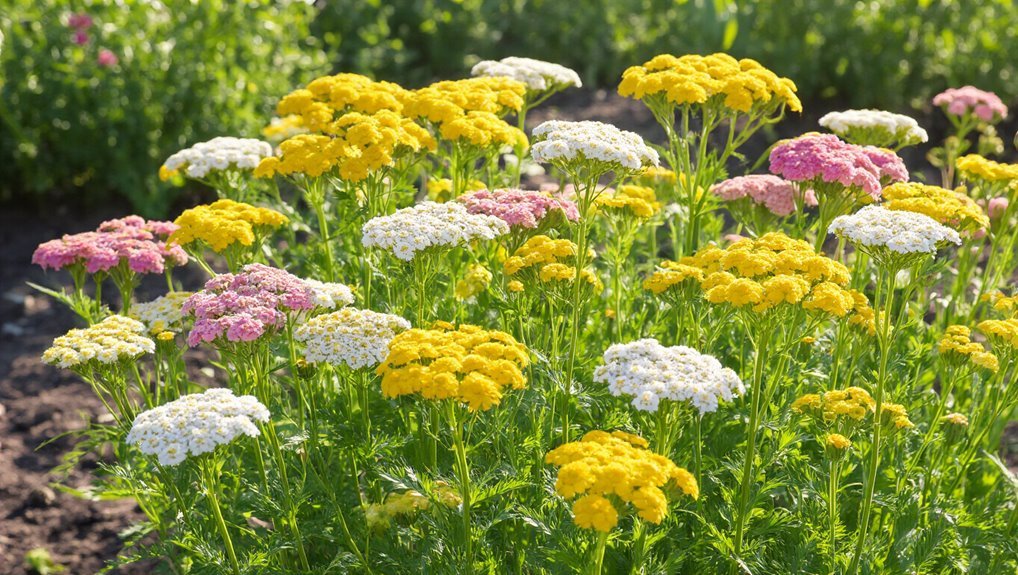
Achillea millefolium, commonly known as yarrow, is a resilient perennial that thrives in full sun and well-drained soil.
This hardy plant’s drought-tolerant nature makes it perfect for low-maintenance gardens. You’ll love how it produces flat clusters of tiny flowers in shades of white, yellow, pink, and red, attracting pollinators like bees and butterflies. Many gardeners also use organic mulching materials such as straw to help maintain soil moisture and further reduce maintenance needs around yarrow.
Plant yarrow in groups for a striking display, and it’ll bloom from late spring to early fall. Its fern-like foliage adds texture and interest even when not in bloom.
Plus, yarrow’s ability to tolerate poor soil conditions means you won’t need to fuss over it. Just give it a bit of space to spread, and you’ll have a vibrant, carefree addition to your flower bed.
For even healthier and more resilient flower beds, consider using mulch to conserve moisture, suppress weeds, and improve soil health around your yarrow and other sun-loving perennials.
Echinacea Purpurea (Purple Coneflower)
When you’re looking to add a splash of color to your full sun flower beds, Echinacea purpurea, or purple coneflower, is an excellent choice. This hardy perennial thrives in sunny conditions and blooms from summer to fall, attracting pollinators like bees and butterflies. You can encourage even more vigorous growth by starting Echinacea seeds indoors using seed starting kits designed for gardeners.
Plus, it’s low-maintenance, making it perfect for busy gardeners.
Here are a few reasons to love purple coneflower:
- Drought-tolerant: It withstands dry spells, so you won’t worry about regular watering.
- Long-lasting blooms: Enjoy vibrant flowers for weeks, adding beauty to your garden.
- Medicinal properties: Traditionally used for its immune-boosting benefits, this plant has more to offer than just looks.
If you want to deepen your knowledge about perennials like Echinacea, consider exploring gardening books for expert tips and essential advice.
Add Echinacea purpurea to your garden, and you won’t be disappointed!
Rudbeckia Hirta (Black-Eyed Susan)
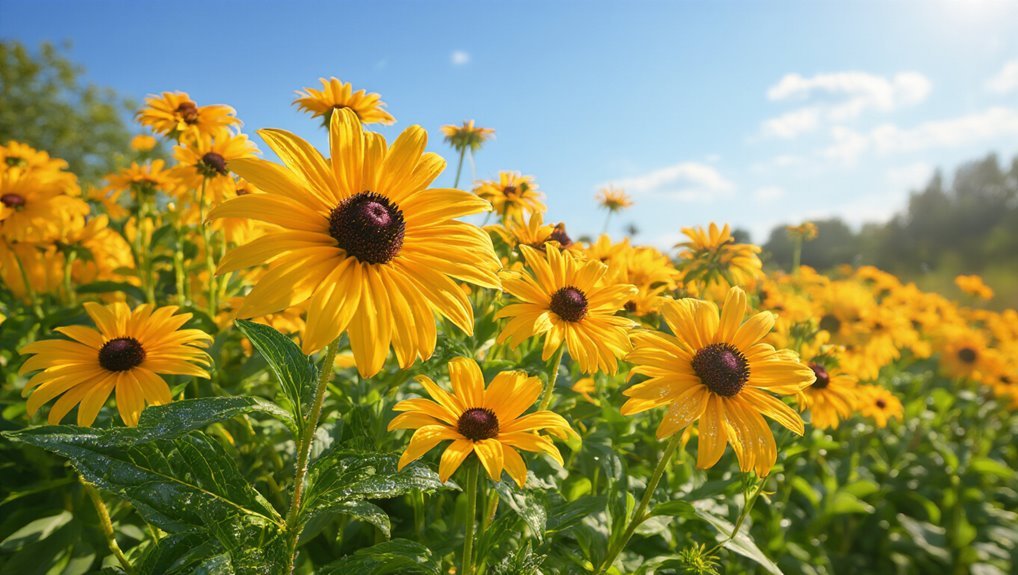
Rudbeckia hirta, commonly known as black-eyed Susan, brings a cheerful burst of yellow to full sun flower beds.
These hardy perennials thrive in well-drained soil and can tolerate drought, making them perfect for low-maintenance gardens. For optimal results, use garden soil that is specifically designed to help your perennials thrive.
With their distinctive dark centers and bright petals, they attract pollinators like bees and butterflies, enhancing your garden’s ecosystem.
You’ll love how they bloom from early summer to fall, providing vibrant color when many other flowers fade.
When planting, space them about 12 to 18 inches apart to allow for their natural spreading.
Deadheading spent blooms encourages even more flowers.
For even healthier black-eyed Susans, enrich your soil with compost bins to provide essential nutrients and improve drainage.
Sedum Spp. (Stonecrop)
Although you might think of succulents as a houseplant staple, Sedum spp., commonly known as stonecrop, thrives beautifully in full sun flower beds.
These hardy perennials are perfect for anyone looking to add low-maintenance color and texture to their garden. Gardeners can also benefit from using Organic Pest Control Solutions to keep these beds healthy without resorting to harsh chemicals.
Here’s why you’ll love Sedum:
- Drought-Tolerant: Once established, they require minimal water, making them ideal for dry spells.
- Varied Shapes and Colors: With numerous varieties, you can enjoy everything from vibrant greens to deep burgundies.
- Pollinator-Friendly: They attract bees and butterflies, enhancing your garden’s ecosystem.
Planting Sedum won’t only beautify your garden but also provide a resilient option that stands up to harsh conditions.
For gardeners interested in natural pest control, you might also want to explore insect repellent plants as a complementary addition to your landscape.
You won’t regret adding these beauties to your flower beds!
Lavandula Angustifolia (English Lavender)
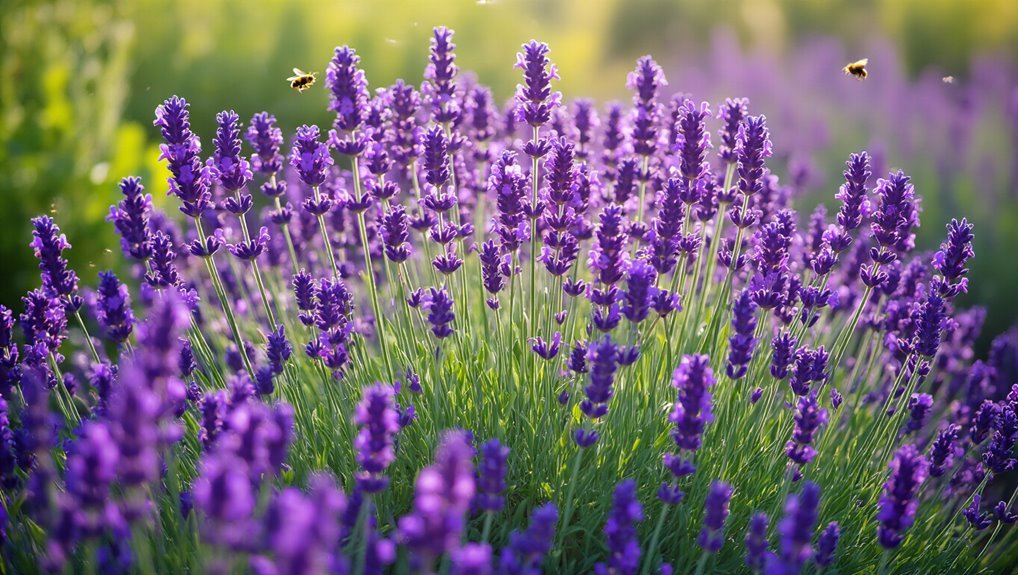
Lavandula angustifolia, or English lavender, brings a touch of elegance and fragrance to full sun flower beds. This perennial thrives in well-drained soil and requires minimal care, making it a perfect choice for busy gardeners.
With its striking purple flowers and silvery-green foliage, it not only adds color but also attracts pollinators like bees and butterflies. Plant it in clusters for a stunning visual impact and to enhance its delightful aroma.
English lavender tolerates drought, so you won’t need to worry about frequent watering once it’s established. Additionally, you can use its flowers for culinary purposes, sachets, or even homemade skincare products.
Salvia Nemorosa (Wood Sage)
Wood sage, or Salvia nemorosa, is a resilient perennial that flourishes in full sun, showcasing vibrant spikes of purple and blue flowers.
This plant not only adds color to your garden but also attracts pollinators, making it a fantastic choice for a lively flower bed.
Here are a few reasons to love Salvia nemorosa:
- Drought-tolerant: Once established, it requires minimal watering, saving you time and effort.
- Long blooming season: Enjoy blooms from late spring to early fall, providing continuous interest.
- Low maintenance: It thrives in poor soil, needing little care beyond occasional deadheading.
With its beauty and hardiness, Salvia nemorosa is a must-have for any sunny garden!
Hemerocallis Spp. (Daylily)
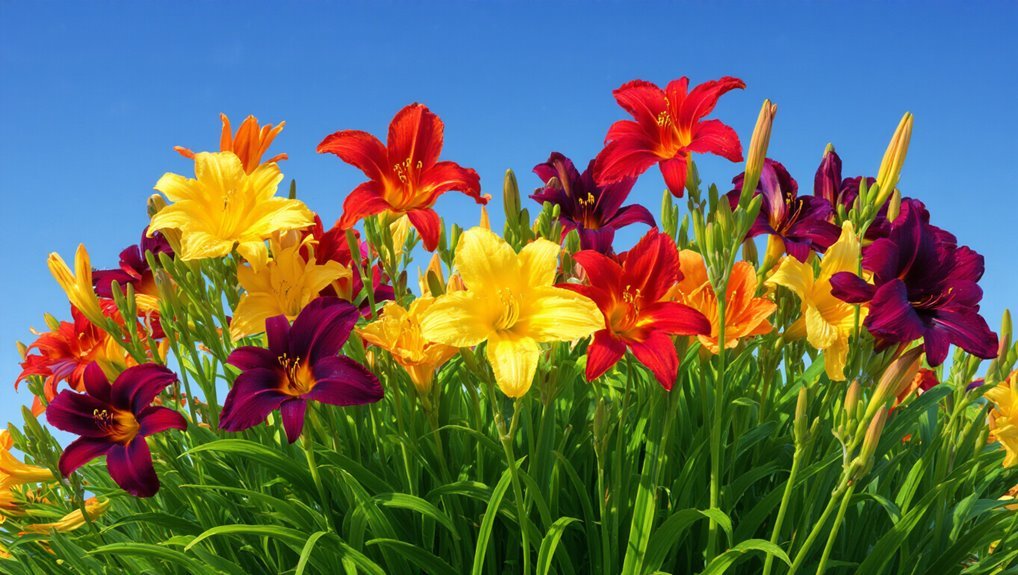
If you’re looking for a vibrant addition to your full sun flower beds, consider Hemerocallis spp., commonly known as daylilies. These hardy perennials thrive in sunny spots, producing stunning blooms in various colors. They’re low-maintenance and adapt well to different soil types, making them a favorite for gardeners.
Here’s a quick comparison of daylily features:
| Feature | Description |
|---|---|
| Bloom Time | Summer |
| Sun Requirements | Full sun to partial shade |
| Height | 1 to 4 feet |
Planting daylilies will provide you with a reliable and beautiful display year after year, making them a perfect choice for your garden. Don’t miss out on their charm!
Gaillardia Spp. (Blanket Flower)
Bright and cheerful, Gaillardia spp., commonly known as blanket flowers, are a fantastic choice for full sun flower beds.
These vibrant perennials bring color and resilience to your garden, thriving in hot and dry conditions. You’ll love their daisy-like blooms that attract pollinators and last all summer long.
Here are a few reasons to plant blanket flowers:
- Low Maintenance: They require minimal watering and care once established.
- Drought Tolerant: Perfect for those tough, sunny spots in your yard.
- Long Blooming Season: Enjoy their stunning flowers from late spring until the first frost.
With their striking hues and sturdy nature, Gaillardia spp. will brighten up your space effortlessly!
Penstemon Spp. (Beardtongue)
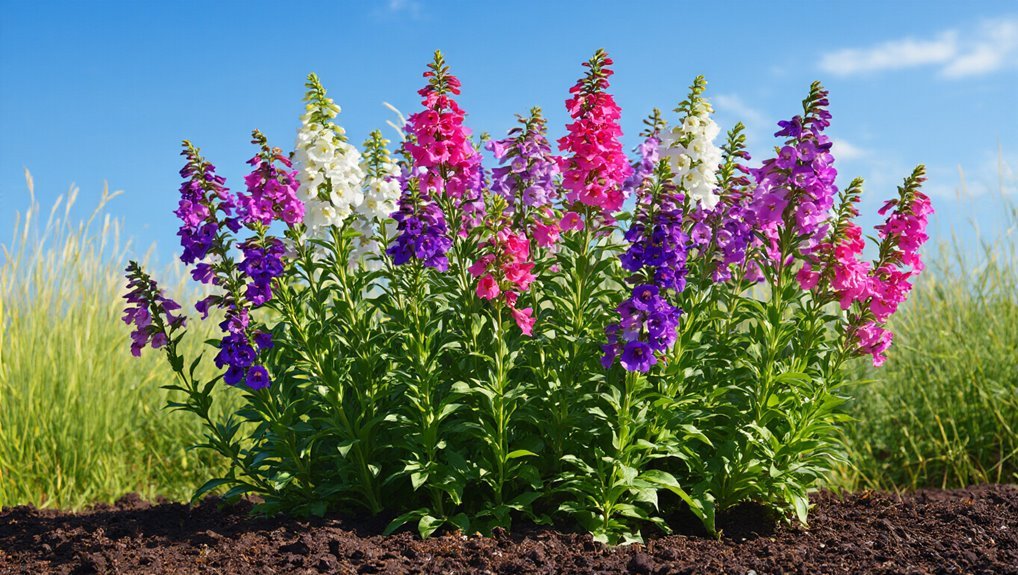
Penstemon spp., commonly known as beardtongue, offers a stunning display of tubular flowers that thrive in full sun. These hardy perennials are not just beautiful; they’re also drought-resistant, making them perfect for low-maintenance gardens. You’ll enjoy their vibrant colors attracting pollinators like bees and hummingbirds.
| Variety | Height | Flower Color |
|---|---|---|
| Penstemon digitalis | 1-3 feet | White to purple |
| Penstemon barbatus | 2-4 feet | Red |
| Penstemon heterophyllus | 1-2 feet | Blue |
| Penstemon angustifolius | 1-3 feet | Yellow |
With a range of heights and colors, you can easily find the perfect penstemon for your garden. Enjoy the long-lasting blooms and easy care these plants provide!
Frequently Asked Questions
How Do I Prepare My Soil for Planting Perennials?
To prepare your soil for planting perennials, start by removing weeds and debris. Then, loosen the soil with a garden fork, mix in organic matter, and ensure proper drainage. It’s essential for healthy growth!
When Is the Best Time to Plant These Perennials?
You’ll want to plant your perennials in spring after the last frost or in early fall. This timing helps them establish roots before extreme temperatures, ensuring a vibrant and healthy garden in the growing season.
How Do I Care for Perennials During Winter?
To care for perennials during winter, you should cut back dead foliage, apply mulch for insulation, and ensure they’re well-watered before the ground freezes. Don’t forget to protect them from harsh winds and extreme temperatures!
Can These Perennials Attract Pollinators to My Garden?
Imagine planting echinacea in your garden. These vibrant flowers attract bees and butterflies, enhancing your garden’s beauty while supporting pollinators. Yes, many perennials can draw in these beneficial creatures, creating a lively ecosystem.
What Pests Should I Watch Out for With These Plants?
You should watch out for aphids, spider mites, and slugs. They can damage your plants and reduce their vitality. Regularly inspect your garden and take action if you notice any signs of these pests.
Conclusion
So, as you stroll through your vibrant flower bed filled with yarrow, coneflowers, and black-eyed Susans, you might just find yourself reminiscing about sunny days spent in your grandma’s garden. These “bomb-proof” perennials thrive under the sun, just like those cherished memories. By choosing hardy plants like English lavender and blanket flowers, you’re not only beautifying your space but also creating new stories to tell. Enjoy the blooms and let them bring a little sunshine to your life!

